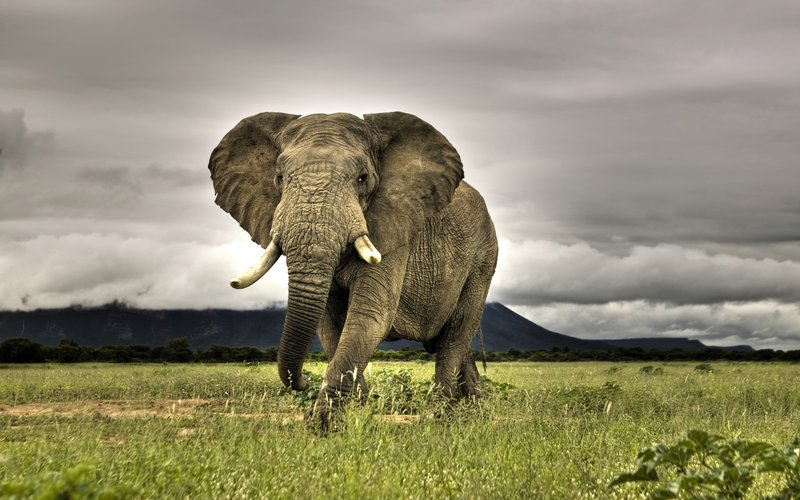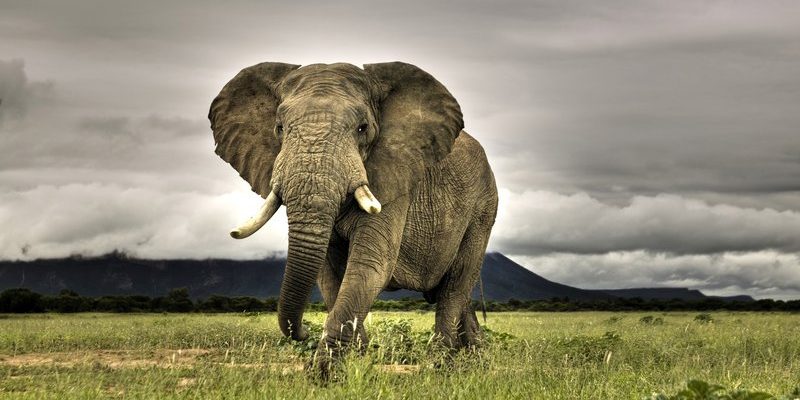
The African Bush Elephant, the largest land animal on Earth, is a fascinating creature that captures our imagination. Imagine standing next to a creature that can weigh up to 14,000 pounds and can be as tall as 13 feet at the shoulder. When you see one in the wild, it’s a reminder of the majesty and power of nature. It’s not just its size that’s impressive; these elephants are social, intelligent, and play a crucial role in their ecosystems.
Although you might think of elephants as gentle giants, they are complex animals with their own challenges and threats. Poaching and habitat destruction pose serious risks to their populations. In this article, we’ll take a deep dive into the life of the African Bush Elephant, exploring everything from their behavior and diet to their social structure and conservation efforts. So, grab a cup of coffee, and let’s explore these majestic creatures together.
Physical Characteristics
African Bush Elephants are often recognized by their enormous ears that resemble the shape of Africa. These ears help them regulate their body temperature, which is vital in the warm climates they inhabit. Their skin, which appears gray and wrinkled, plays a significant role in keeping them cool by retaining water and protecting them from sunburn. You could almost think of it as nature’s way of providing them with a natural sunscreen.
Their tusks are another iconic feature. Made of ivory, these tusks can grow to be quite long, sometimes reaching over 10 feet. While they use their tusks for digging, lifting, and stripping bark from trees, they also sadly make them targets for poachers. Each elephant’s tusks can tell a tale of its life; left and right tusks often grow at different rates, reflecting their unique experiences.
On average, male African Bush Elephants can weigh between 10,000 and 14,000 pounds, while females typically weigh slightly less. Their height can range from 10 to 13 feet, but don’t let the numbers overwhelm you. When you see one in the wild, it’s the sheer presence and grace they carry that truly leaves you in awe.
Habitat and Distribution
The African Bush Elephant primarily inhabits savannas, grasslands, and forested areas across sub-Saharan Africa. You can find them roaming in countries like Tanzania, Botswana, and Kenya. They prefer open spaces that allow them to forage for food, and their large size doesn’t hinder their movement; they can walk several miles each day in search of food and water.
Interestingly, these elephants are semi-nomadic, meaning they often migrate in search of seasonal resources. During the dry season, they may travel long distances to find water sources, exemplifying their adaptability to changing environments. This behavior is crucial not only for their survival but also for the ecosystems they inhabit, as they help create paths and clearings that other animals benefit from.
While these elephants thrive in their natural habitats, human activities like agriculture and urban development pose significant threats. As more land is cleared for farming or cities, elephants face habitat loss, which forces them to venture into populated areas, leading to human-elephant conflict.
Diet and Feeding Habits
The diet of the African Bush Elephant is as vast as they are. These herbivores consume a variety of plants, including grasses, leaves, bark, and fruit. They need a staggering amount of food each day—up to 300 pounds! Think about that for a moment: that’s like eating a small car’s worth of food daily. Their voracious appetite means they play a vital role in their ecosystem by maintaining the ecological balance.
One of their favorite snacks is the fruit of the baobab tree. Known for its unique shape and long lifespan, the baobab tree provides not only food but also moisture, which is particularly important during dry spells. You might even say these elephants are like natural gardeners, dispersing seeds as they eat, helping various plant species to thrive across their territory.
Feeding isn’t just a solitary activity for them; it’s often a social event. Family units gather together to forage, sharing information about food sources. This cooperative behavior highlights their social structure and strong family bonds. When you watch them feeding, it’s not just about survival; it’s about maintaining connections and traditions within their family groups.
Social Structure and Behavior
Elephants are known for their complex social structures, and the African Bush Elephant is no exception. They live in family groups led by a matriarch, usually the oldest and most experienced female. This matriarch is key to the group’s survival, as she knows where to find food and water, and she often leads them through migratory routes. The bonds among family members are incredibly strong, and they exhibit remarkable behaviors such as comforting and assisting one another.
These elephants communicate using a range of vocalizations and body language. From trumpeting sounds to low rumbles that can be heard over long distances, their communication is sophisticated. It’s similar to a language; they can express emotions, warnings, and even greeting messages. You might be surprised to know that they can also “talk” through the ground by sending vibrations, which other elephants can sense.
Social interactions aren’t just limited to their family groups. They also participate in larger gatherings, where herds come together for special occasions like watering holes or mating seasons. Observing these interactions can provide incredible insights into their emotions; you might witness playful sparring among young elephants or tender moments where they comfort each other after a stressful event. It truly illustrates their deep emotional intelligence.
Conservation Status and Threats
Despite their grandeur and importance to ecosystems, African Bush Elephants are currently endangered. The primary threat to their survival is poaching for ivory, which remains a lucrative black market. Poachers often kill these magnificent animals for their tusks, leaving behind devastating impacts on their population and social structures. It’s heartbreaking to think about the loss of not just individuals, but entire family groups due to this brutal practice.
Another significant threat is habitat destruction caused by human expansion. As land is cleared for farming or urban development, elephants lose their natural homes. This encroachment leads to increased conflicts between elephants and humans, often resulting in tragic outcomes for both parties. You may find it difficult to fathom, but as elephants wander into human settlements searching for food, they can cause damage, leading to retaliation against them.
Conservation efforts are underway to protect these gentle giants. Many organizations are working tirelessly to combat poaching, rehabilitate injured elephants, and raise awareness about their plight. Laws have been enacted to ban the ivory trade, and many protected areas have been established to provide safe havens for elephants. Your awareness and support can make a difference. Every little bit counts in the fight to protect these incredible animals.
Interesting Facts
| Scientific Name: | Loxodonta africana |
| Height: | 10 to 13 feet |
| Weight: | 10,000 to 14,000 pounds |
| Lifespan: | 60 to 70 years |
| Diet: | Herbivore |
| Gestation: | 22 months |
FAQ
What is the biggest threat to African Bush Elephants?
The largest threat facing African Bush Elephants today is poaching for ivory. Despite international bans, the demand for ivory continues to drive illegal hunting. Additionally, habitat loss due to human activities such as agriculture and urban development exacerbates their situation.
How do African Bush Elephants communicate?
African Bush Elephants communicate through a variety of vocalizations, including trumpets, rumbles, and even subtle body language. They can also send vibrations through the ground, allowing them to communicate over long distances, which is quite remarkable.
What is the family structure of African Bush Elephants?
African Bush Elephants typically live in matriarchal family groups led by the oldest female. The social bonds within these groups are strong, and they work together to support one another in their daily lives, including foraging and protecting their young.
What do African Bush Elephants eat?
As herbivores, African Bush Elephants have a diverse diet that includes grasses, leaves, bark, and fruits. They consume massive amounts of food daily, sometimes up to 300 pounds, which helps maintain the ecological balance of their habitats.
Can African Bush Elephants swim?
Yes, African Bush Elephants are excellent swimmers! They use their trunk as a snorkel while swimming. They often enjoy cool dips in water bodies during hot days, which also helps to regulate their body temperature.
How long do African Bush Elephants live?
In the wild, African Bush Elephants can live for about 60 to 70 years. This longevity allows them to pass down valuable knowledge and experiences to younger generations, especially within family groups led by matriarchs.
Are African Bush Elephants endangered?
Yes, African Bush Elephants are classified as endangered due to factors such as poaching, habitat loss, and human-elephant conflict. Conservation efforts are ongoing to protect their populations and habitats.
Do African Bush Elephants have any natural predators?
Adult African Bush Elephants have very few natural predators due to their size. However, calves are vulnerable to large predators such as lions and crocodiles. The protective nature of the matriarch and other family members helps guard the young against potential threats.
How do African Bush Elephants help their ecosystem?
African Bush Elephants are often referred to as “keystone species” because they play a crucial role in their ecosystems. By browsing and foraging, they help to shape the landscape, create paths for other animals, and disperse seeds, contributing to plant diversity and overall ecosystem health.
What is the average size of an African Bush Elephant’s tusks?
The tusks of an African Bush Elephant can vary greatly in size, but they can grow to be over 10 feet long in some cases. These tusks are used for digging, lifting objects, and stripping bark from trees, playing a significant role in their daily activities.

